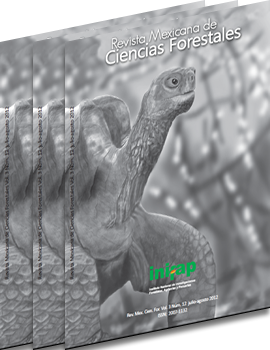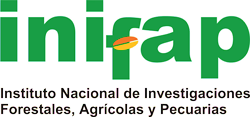RAPDS PROFILES ASSOCIATED TO THE RESISTANCE TO HIGH LIGHT INTENSITY OF POLES
DOI:
https://doi.org/10.29298/rmcf.v3i12.509Keywords:
Abies religiosa (Kunth) Schltdl. et Cham., stomata aperture, stomata, molecular marker, umbraphyla plant, assisted selectionAbstract
Abies religiosa has great potential as urban forest tree, Christmas-tree, bonsai, timber, paper, ceiling, medicinal, and carbon sequestration. However, plantations are not possible without tree covering, because this species is shade tolerant, and their seedlings are susceptible to high intensity light. Nevertheless, A. religiosa shows natural intraspecific variation in resistance to high intensity light. Because of this and because exist interspecific phenotipic variation for resistance to high intensity light. The probability that there is a genetic basis for the intraspecific variation must be high. The aim of this study was to detect RAPD profiles associated with resistance to high intensity light on A. religiosa seedlings. The DNA from 15 resistant and 15 susceptible seedlings to high intensity light were isolated. Two bulked samples were formed and 35 primers were evaluated. From primers with PCR products, a second PCR reaction with DNA from individual seedlings was done. Registered data were: seedling survival to high intensity light, leaf number, stomata aperture, stomata number, and plant height. Correlations between these variables, and RAPDs profiles for each primer were computed. Bands which correlated with all variables were detected. 24 % of the seedlings survived to high intensity light. Stomata width and aperture showed the largest number of correlations. The 1801.92 pb band from primer 5’-CCGGCCTTCC-3’ was correlated with almost all variables. This suggests that survival, height, leaf number, and stomata aperture are genetically controlled variables. Seedling survival to high intensity light is mainly determined by stomata aperture.
Downloads
Downloads
Published
How to Cite
Issue
Section
License
The authors who publish in Revista Mexicana de Ciencias Forestales accept the following conditions:
In accordance with copyright laws, Revista Mexicana de Ciencias Forestales recognizes and respects the authors’ moral right and ownership of property rights which will be transferred to the journal for dissemination in open access.
All the texts published by Revista Mexicana de Ciencias Forestales –with no exception– are distributed under a Creative Commons License Attribution-NonCommercial 4.0 International (CC BY-NC 4.0), which allows third parties to use the publication as long as the work’s authorship and its first publication in this journal are mentioned
The author(s) can enter into independent and additional contractual agreements for the nonexclusive distribution of the version of the article published in Revista Mexicana de Ciencias Forestales (for example, include it into an institutional repository or publish it in a book) as long as it is clearly and explicitly indicated that the work was published for the first time in Revista Mexicana de Ciencias Forestales.
For all the above, the authors shall send the form of Letter-transfer of Property Rights for the first publication duly filled in and signed by the author(s). This form must be sent as a PDF file to: ciencia.forestal2@inifap.gob.mx
This work is licensed under a Creative Commons Attribution-Noncommercial 4.0 International license.






